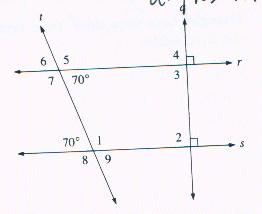|
|
|
|
Parallel Lines and Perpendicular Lines |
| Objective:
Recognize perpendicular lines and their properties. |
|
Vocabulary: Plane, parallel, transversal, alternate interior angles, corresponding angles, vertical angles, midpoint, congruent segments, segment bisector, perpendicular, perpendicular bisector |
| A point
is a position in space with no length, width, or thickness.
. P Symbol P |
A segment
is two points on a line and the points on the line between them.
|
A ray
is a part of a line that has one endpoint and extends endlessly in one
direction.
|
A line
is a straight path of points that
goes on endlessly in both directions.
|
| A plane is a flat surface.
|
An
angle
is formed by two
rays from the same endpoint or vertex.
Symbol: <ABC or <B |
Parallel lines
are lines that
are in the same plane and never cross because they are always the same
distance apart.
_________________ _________________ Symbol | | |
Perpendicular lines are two lines that intersect to form
right angles.
Symbol _|_ |
|
:
|
|
Line 1 and Line 2 are parallel lines Line 3 is a transversal a line that intersect two or more parallel lines. When a transversal intersects two lines, it forms eight angles. The angles have special names: Corresponding angles are in the same position from one line to the other. There are four pairs of corresponding angles: <E and <A, <F and <B, <C and <G, <D and <H. Alternate interior angles are on opposite sides of the transversal an on the inside of the lines it intersects. There are two pairs of alternate interior angles: <C and <B, <D and <A. Alternate exterior angles are on opposite sides of the transversal and on the outside of the lines it intersects. There are two pairs of alternate exterior angles: <E and <H and <F and <G. Vertical angles are across from each other. There are four pairs of vertical angles: <E and <D, <F and <C, <A and <H, <B and <G. In the two intersecting lines are parallel, the angles that are formed by the transversal have special figures: Corresponding angles are congruent, alternate exterior angles are congruent, alternate interior angles are congruent. |
|
|
| A line segment is formed by
two endpoints and all the points between them. If the line segment
is intersected at its midpoint
M, the point that divides it into two congruent segments. Congruent
segments have equal lengths. Line PQ is the segment
bisector of line segment AB because
it passes through the midpoint M. If the bisector is perpendicular
it is called a perpendicular
bisector. Line PQ is the Perpendicular
bisector to line segment AB.
|
|
----------------------Try It------------------------------- |
|
Use the figure at the right to answer the following: r | | s, q _|_ r and q _|_ s.
1. Name three right angles. 2. Name two transversals of lines r and s. 3. Name two transversals of lines t and q. 4. What is the measure of <1? 5. What other angles have the same measure as <1? 6. What is the measure of <9? 7. What is the measure of <6? 8. Name two alternate interior angles, corresponding angles, supplementary angles and vertical angles.
|
 |
|
Parallel Lines and Perpendicular Lines Quiz Remember to ask Ms Painter for the password. |
 |
 |
|
|
| 1) <3, <4, <2 | 3) r and s | 5) <5, <7, <8 | 7) 70º |
| 2) t and q | 4) 110º | 6) 70º | 8) Interior angles <7,
<1
Corresponding angles <5,<1 Supplementary angles <5, <6 Vertical angles <1, <8 |